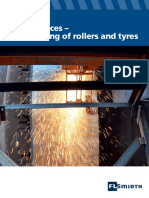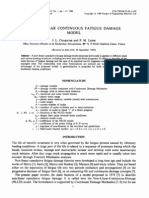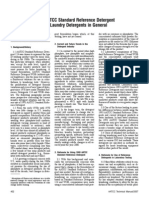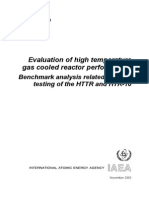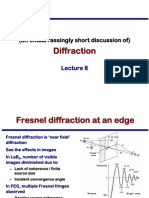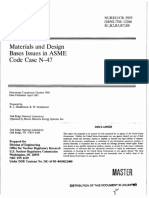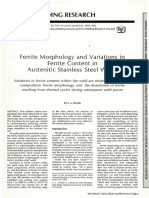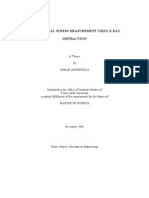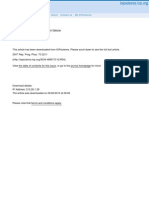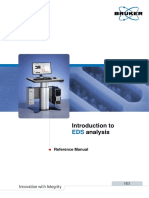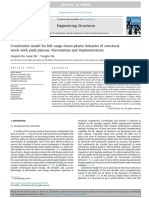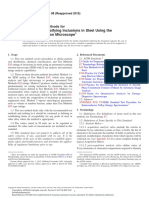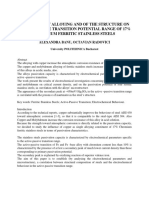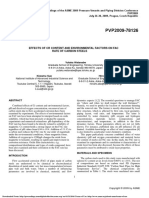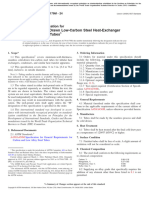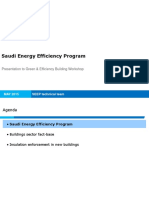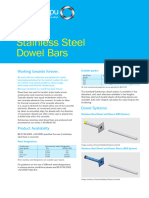Etching Stainless Steels For Delta Ferrite
Etching Stainless Steels For Delta Ferrite
Uploaded by
APICopyright:
Available Formats
Etching Stainless Steels For Delta Ferrite
Etching Stainless Steels For Delta Ferrite
Uploaded by
APIOriginal Description:
Original Title
Copyright
Available Formats
Share this document
Did you find this document useful?
Is this content inappropriate?
Copyright:
Available Formats
Etching Stainless Steels For Delta Ferrite
Etching Stainless Steels For Delta Ferrite
Uploaded by
APICopyright:
Available Formats
TECH SPOTLIGHT
Color etching and
electrolytic
etching can help
metallographically
evaluate delta
ferrite content.
100 Pm
Fig. 2 Mill Clad 3 (MC3) is a weld cladding for rebuilding caster rolls, hot strip mill rolls, and other types of steel mill rolls. When the
as-welded steel is etched with the color etch, the delta ferrite as well as the general microstructure of the weld is revealed
Etching Stainless Steels for Delta Ferrite
Timken Co.
Canton, Ohio
methodology for calculating the
approximate ferrite content in
austenitic stainless steel welds
was first described by Schaeffler in
1949. Subsequently, the original diagram was revised by DeLong, and
later revised by the Welding Research
Council several times (Fig. 1).
Based on the composition of the
stainless steels being welded, a nickel
and chromium equivalent of the
weld metal is calculated using Equations 1 and 2.
Creq. = %Cr + 1.5 x %Si + %Mo +
0.5% x (%Ta + %NB) + 2 x %Ti +
%(W + V + Al)
(Eq. 1)
Nieq. + %Ni + 30 x %Co +
0.5 x %Mn + 0.5 x %Co (Eq. 2)
Because the actual amount of ferrite in stainless steels depends on
non-equilibrium solidification processing as well as composition, several different techniques would be
*Fellow of ASM International
suitable to actually measure the ferrite content of the weld metal. This
tech note will describe how color
etching and electrolytic etching can
metallographically evaluate the delta
ferrite content of two martensitic
stainless steels as shown in the table.
The color etch in these examples
was a modified potassium metabisulfite etch composed of 1% HCl, 1g
K2S2O5, and 1g NH4HFH in 100 ml of
distilled water. Approximately 15
seconds was required to etch the
specimens.
The electrolytic etch was ASTM
E407 number 220. This etch is composed of 20g of NaOH in 100 ml of
distilled water. The specimens were
etched at 6 volts for approximately
30 seconds.
0% D
30
10% D
20% D
Austenite
Nickel equivalent, %
Dennis W. Hetzner*
20
40% D
A+M
80% D
10
Martensite
M+F
Ferrite
10
Weld cladding
Mill Clad 3 (MC3) is a weld
cladding for rebuilding caster rolls,
hot strip mill rolls, and other types of
steel mill rolls. When the as welded
20
30
Chromium
equivalent, %
40
Fig. 1 Modified Schaeffler diagram for
the delta ferrite content in austenitic stainless steel welds.
Martensitic stainless steel compositions
Element
Si
Mn
Cr
Mo
Ni
Co
Cb (Nb)
MC3 Weld
0.12
0.40
1.1
12.7
1.4
2.8
0.2
0.2
Wrought P675
0.07
0.40
0.65
13.0
1.8
2.6
0.6
5.4
ADVANCED MATERIALS & PROCESSES/FEBRUARY 2007
33
CLEMEX
3. For this field of view, the delta ferrite content of this weld appears to
be in the range of 10% to 15%.
Equations 1 and 2 show that the
chromium and nickel equivalents for
this alloy are 15.0% and 6.95% respectively. Reference to the modified
Schaeffler diagram indicates that this
compositional point is in the M + F
phase field, and the exact amount of
each phase is difficult to predict.
intelligent microscopy
Rapid Inclusion Rating Analysis
50 Pm
Fig. 3 Electrolytic NaOH. When the
specimen is etched with the electrolytic etch,
only the delta ferrite is attacked.
NEW
ISO
Inclusion
Rating
software
CIR 5.0
Compliant with
International Standards
Analyze multiple samples
from multiple heats
50 Pm
Fig. 4 Alloy P675 is carburizable
bearing steel manufactured by Carpenter
Technology. For a specimen given a heat
treating cycle similar to that for hardening
carburized components, the color etch clearly
reveals the delta ferrite as white stringers in
the longitudinal microstructure.
Multi-field mapping of entire
sample for validation
Auto-detection of
sample edges
Analyze 200 mm2 in less
than 3 minutes!
50 Pm
Fig. 5 Electrolytic NaOH. After electrolytic etching, the delta ferrite is once again
clearly revealed. However, the contrast between the delta ferrite and the unetched matrix is not as high as that for the color etch.
www.clemex.com
steel is etched with the color etch, the
delta ferrite as well as the general microstructure of the weld is revealed,
Fig. 2. However, when the specimen
is etched with the electrolytic etch,
only the delta ferrite is attacked, Fig.
Bearing steel
Alloy P675 is carburizable bearing
steel manufactured by Carpenter
Technology. For a specimen given a
heat treating cycle similar to that for
hardening carburized components,
the color etch clearly reveals the delta
ferrite as white stringers in the longitudinal microstructure, Fig. 4. Microstructural banding is clearly revealed by the color etch as long dark
streaks in the microstructure. After
electrolytic etching, the delta ferrite
is once again clearly revealed. However, the contrast between the delta
ferrite and the unetched matrix is not
as high as that for the color etch, as
shown in Fig. 5.
Multiple fields of view for this
specimen indicate that the amount
of delta ferrite is less than 1%. For
this alloy, the chromium and nickel
equivalents are found to be 16.0%
and 7.7% respectively. Once again
this composition in contained within
the M + F phase field, Fig. 1.
Several interesting observations
can be made from these results. For
both alloys, electrolytic sodium hydroxide clearly reveals only the delta
ferrite. The same would be true for
revealing delta ferrite in austenitic
stainless steel welds. The color etch
clearly revealed the delta ferrite in
the wrought stainless steel. However, for the weld metal, the color
etch revealed several different microstructural features. Thus, the delta
ferrite was difficult to measure.
Although there was not a great
deal of difference in the chromium
and nickel equivalents for the alloys,
the processing greatly affected the
amount of delta ferrite in the steels.
All these facts are revealed by careful
metallography.
For more information: Dr. Dennis
Hetzner is a senior materials specialist at
the Timken Co., Canton, OH 44706; tel:
330/471-2150; dennis.hetzner@timken.com.
ADVANCED MATERIALS & PROCESSES/FEBRUARY 2007
You might also like
- Convective Heat & Mass Transfer - William Kays - 3rd EdDocument635 pagesConvective Heat & Mass Transfer - William Kays - 3rd EdSagar Pradhan100% (4)
- Paraklesis Great SERVICEDocument23 pagesParaklesis Great SERVICEDanielNo ratings yet
- BS en Iso 2398-2016Document18 pagesBS en Iso 2398-2016API100% (1)
- Kiln Services Resurfacing of Rollers and TyresDocument4 pagesKiln Services Resurfacing of Rollers and TyresAPINo ratings yet
- A Non-Linear Continuous Fatigue DamageDocument17 pagesA Non-Linear Continuous Fatigue DamageMaroua MahouachiNo ratings yet
- Scanning Electron MicroscopDocument21 pagesScanning Electron Microscopabhishek ranaNo ratings yet
- Effect of Intermetallic Phases On Corrosion Resistance of Superduplex and Superaustenitic Stainless Steel WeldmentsDocument13 pagesEffect of Intermetallic Phases On Corrosion Resistance of Superduplex and Superaustenitic Stainless Steel WeldmentsedpsousaNo ratings yet
- AP621 Lect02 DiffractionDocument117 pagesAP621 Lect02 DiffractionHassanNo ratings yet
- Aatcc DetergentDocument2 pagesAatcc DetergentOliver Everett Espino100% (1)
- Astm E407Document22 pagesAstm E407Carlos Pinto PradillaNo ratings yet
- Svensk Standard SS-EN 1149-1:2006: Del 1: Ytresistivitet (Provningsmetoder Och Fordringar)Document6 pagesSvensk Standard SS-EN 1149-1:2006: Del 1: Ytresistivitet (Provningsmetoder Och Fordringar)Vishal0% (1)
- TE 1382 Part1Document231 pagesTE 1382 Part1arifanovNo ratings yet
- Sensitization in Austenitic Stainless Steels - Quantitative Prediction - Thesis 2020Document116 pagesSensitization in Austenitic Stainless Steels - Quantitative Prediction - Thesis 2020Adnan SaadiNo ratings yet
- The Serpentine Mineral GroupDocument3 pagesThe Serpentine Mineral GroupYudhi PrawiraNo ratings yet
- Belleville SpringsDocument26 pagesBelleville SpringsMuthu Kumar RNo ratings yet
- Transmission Electron Microscopy Skills:Diffraction Lecture 9Document25 pagesTransmission Electron Microscopy Skills:Diffraction Lecture 9LIAKMANNo ratings yet
- Materials and Design Bases Issues in Code Case: Asme N-47Document36 pagesMaterials and Design Bases Issues in Code Case: Asme N-47Bryan ManaloNo ratings yet
- Bob-Stern Roseville NCSLI 1410Document23 pagesBob-Stern Roseville NCSLI 1410makara5966No ratings yet
- NULIFE-07-21 - Guideline For The Development of High Quality SCC Growth DataDocument26 pagesNULIFE-07-21 - Guideline For The Development of High Quality SCC Growth DataOtso CronvallNo ratings yet
- Detecting Transformation From Delta Ferrite To Sigma Phase in SsDocument9 pagesDetecting Transformation From Delta Ferrite To Sigma Phase in SsAndrea CalderaNo ratings yet
- Review of Residual Stresses-FinalDocument50 pagesReview of Residual Stresses-FinalAsif HameedNo ratings yet
- XRD Determination of Subsurface Cold Work Distributions PDFDocument2 pagesXRD Determination of Subsurface Cold Work Distributions PDFCaner SimsirNo ratings yet
- Materials: Electrochemical Polishing of Austenitic Stainless SteelsDocument25 pagesMaterials: Electrochemical Polishing of Austenitic Stainless SteelsSebin AbrahamNo ratings yet
- Astm F3122 14 2022Document4 pagesAstm F3122 14 2022Reginald ElvisNo ratings yet
- Sources of Oxygen Contamination in SAW - EagerDocument5 pagesSources of Oxygen Contamination in SAW - EagerAndres CasteloNo ratings yet
- Slag Metal ReactionsDocument7 pagesSlag Metal ReactionsEr Dikshant Malhotra100% (1)
- ASTM E1508 12a 2019Document4 pagesASTM E1508 12a 2019alexanderaristizabalNo ratings yet
- Astm b498 b498m 98 Acsr用镀锌钢芯线 英文 AcsrDocument4 pagesAstm b498 b498m 98 Acsr用镀锌钢芯线 英文 AcsrnarinderNo ratings yet
- Atmospheric Corrosion of Materials PDFDocument24 pagesAtmospheric Corrosion of Materials PDFMarcos LeiteNo ratings yet
- The Akathist Hymn To The Most Holy TheotokosDocument44 pagesThe Akathist Hymn To The Most Holy TheotokosEmilian Anastopoulos RaduNo ratings yet
- This Portable ESD Test Instrument Provides Both RTTDocument8 pagesThis Portable ESD Test Instrument Provides Both RTTmayNo ratings yet
- Review Article: A State-Of-The-Art Review On Fatigue Life Prediction Methods For Metal StructuresDocument14 pagesReview Article: A State-Of-The-Art Review On Fatigue Life Prediction Methods For Metal StructuressenthilNo ratings yet
- Defects in Castings: Book: Foundry Technology by Peter Beeley (Class Slides Are Sufficient)Document13 pagesDefects in Castings: Book: Foundry Technology by Peter Beeley (Class Slides Are Sufficient)HarisankarNo ratings yet
- Non-Specular (NS) Surface Finish On Overhead Aluminum Electrical ConductorsDocument2 pagesNon-Specular (NS) Surface Finish On Overhead Aluminum Electrical Conductorsmoham akhNo ratings yet
- Pourbaix Diagrams For The Ternary System of Iron-Chromium-NickelDocument11 pagesPourbaix Diagrams For The Ternary System of Iron-Chromium-NickelOscar Herrera AmézquitaNo ratings yet
- Ferrite Morphology and Variations inDocument9 pagesFerrite Morphology and Variations inAndrea CalderaNo ratings yet
- Surfaceb Finish Meterology TutorialDocument162 pagesSurfaceb Finish Meterology TutorialChristian Barnard100% (1)
- Residual Stress Measurement Using X-RayDocument76 pagesResidual Stress Measurement Using X-RaynaturexyzNo ratings yet
- Residual Stress and Its Role in FailureDocument55 pagesResidual Stress and Its Role in FailureEagle SpiritNo ratings yet
- Residual Stress: What Are Residual StressesDocument2 pagesResidual Stress: What Are Residual StressesvijayjaghanNo ratings yet
- Octoechos Tone 4Document67 pagesOctoechos Tone 4Jorge Luque-MartinNo ratings yet
- Corrosion LabDocument9 pagesCorrosion LabMuhammad Umair0% (1)
- CH.4. PP: Assivity AssivityDocument38 pagesCH.4. PP: Assivity Assivity이선엽100% (1)
- Prediction of Residual Stress and Distortion From PDFDocument60 pagesPrediction of Residual Stress and Distortion From PDF임학진No ratings yet
- Residual Stress Distributions and Their Influence On Fatigue LifetimesDocument9 pagesResidual Stress Distributions and Their Influence On Fatigue LifetimesPandhari Sanap100% (1)
- Trilon D Liquid: Technical InformationDocument6 pagesTrilon D Liquid: Technical InformationCarmen LinaresNo ratings yet
- Study Material On Passivity and Corrosion by Dr. D. M. PatelDocument15 pagesStudy Material On Passivity and Corrosion by Dr. D. M. PatelAbdalla OmarNo ratings yet
- Introduction To EDS AnalysisDocument53 pagesIntroduction To EDS AnalysisDejan NaumovNo ratings yet
- Annals of Nuclear Energy: Y. Zhang, T. LuDocument15 pagesAnnals of Nuclear Energy: Y. Zhang, T. Luhafiz71196No ratings yet
- ASTM 2017 - Annual HandbooksDocument7 pagesASTM 2017 - Annual HandbooksAkbar ShaikNo ratings yet
- Fatigue LifA State-Of-The-Art Review On Fatigue Life Prediction Methods For Metal StructuresDocument14 pagesFatigue LifA State-Of-The-Art Review On Fatigue Life Prediction Methods For Metal StructuresMona AwadNo ratings yet
- The Effect of Residual Stress and Crack Closure On Fatigue CrackDocument304 pagesThe Effect of Residual Stress and Crack Closure On Fatigue CrackTácito PicançoNo ratings yet
- 491palmer Copper Oxide SolubilityDocument6 pages491palmer Copper Oxide SolubilityauriumrsNo ratings yet
- Prayers Before Sleep: Cross and A BowDocument7 pagesPrayers Before Sleep: Cross and A BowSteven BarberNo ratings yet
- Constitutive Model For Full-Range Elasto-Plastic Behavior of Structural Steels With Yield Plateau Formulation (Hu, Et Al. 2016)Document12 pagesConstitutive Model For Full-Range Elasto-Plastic Behavior of Structural Steels With Yield Plateau Formulation (Hu, Et Al. 2016)Jose ManuelNo ratings yet
- Astm G58.25944Document8 pagesAstm G58.25944Bryan de BarrosNo ratings yet
- Astm - E2142.5170Document14 pagesAstm - E2142.5170Moisés Oliveira100% (1)
- Behavior of 304L 316L and 316 Ss in Pressurized Water Reactor Primary Circuits - Feron2012 PDFDocument14 pagesBehavior of 304L 316L and 316 Ss in Pressurized Water Reactor Primary Circuits - Feron2012 PDFMac NeryNo ratings yet
- Characterization of The Weld Structure in A Duplex Stainless Steel Using Color MetallographyDocument11 pagesCharacterization of The Weld Structure in A Duplex Stainless Steel Using Color MetallographyAndrea CalderaNo ratings yet
- 06 HWDocument1 page06 HWRani Kusuma WardaniNo ratings yet
- Effects of Steel Coatings On Electrode Life in Resistance Spot Welding of Galvannealed Steel SheetsDocument7 pagesEffects of Steel Coatings On Electrode Life in Resistance Spot Welding of Galvannealed Steel Sheetssongyang hanNo ratings yet
- Laser Beam Welding of Superduplex Stainless Steel With Post-Heat TreatmentDocument7 pagesLaser Beam Welding of Superduplex Stainless Steel With Post-Heat Treatmentskeggia85No ratings yet
- The Effect of Alloying and of The Structure On Active-Passive Transition Potential Range of 17% Chromium Ferritic Stainless SteelsDocument6 pagesThe Effect of Alloying and of The Structure On Active-Passive Transition Potential Range of 17% Chromium Ferritic Stainless SteelsBANUNo ratings yet
- Failure Analysis of A Passenger Car Coil SpringDocument6 pagesFailure Analysis of A Passenger Car Coil SpringAPINo ratings yet
- Failure of An Intermediate Gearbox of A HelicopterDocument16 pagesFailure of An Intermediate Gearbox of A HelicopterAPINo ratings yet
- Damage Tolerance Based Shape Design of A Stringer Cutout Using Evolutionary Structural OptimisationDocument20 pagesDamage Tolerance Based Shape Design of A Stringer Cutout Using Evolutionary Structural OptimisationAPINo ratings yet
- Failure Analysis and Optimization Design of A Centrifuge RotorDocument9 pagesFailure Analysis and Optimization Design of A Centrifuge RotorAPINo ratings yet
- Embrittlement Evaluation and Lifetime Assessment of Hydrocracking Pressure Vessel Made of 3Cr 1mo Low Alloy Steel 2007Document6 pagesEmbrittlement Evaluation and Lifetime Assessment of Hydrocracking Pressure Vessel Made of 3Cr 1mo Low Alloy Steel 2007APINo ratings yet
- Journal of Failure Analysis and Prevention Tools & Techniques of Failure AnalysisDocument1 pageJournal of Failure Analysis and Prevention Tools & Techniques of Failure AnalysisAPINo ratings yet
- Failure Analysis of A Turbo DiskDocument7 pagesFailure Analysis of A Turbo DiskAPINo ratings yet
- Failure Analysis of A Leak Off Oil Pipe From Injection Valves of An Off Shore Operating Diesel Engine - 2007 - Engineering Failure Analysis PDFDocument13 pagesFailure Analysis of A Leak Off Oil Pipe From Injection Valves of An Off Shore Operating Diesel Engine - 2007 - Engineering Failure Analysis PDFAPINo ratings yet
- Corrosion of 304SS in Sufuric AcidDocument11 pagesCorrosion of 304SS in Sufuric AcidAPINo ratings yet
- Bondstrand PDFDocument8 pagesBondstrand PDFkrisNo ratings yet
- BS en 12819-2009Document34 pagesBS en 12819-2009APINo ratings yet
- Caustic SCC Paper 080, (ACA, Corrosion Control 007, 2007 Sydney, Australia)Document8 pagesCaustic SCC Paper 080, (ACA, Corrosion Control 007, 2007 Sydney, Australia)APINo ratings yet
- NDE of TubesDocument1 pageNDE of TubesAPINo ratings yet
- Effects of CR Content and Environmental Factors On Flow Accelerated Corrosion Rate of Carbon SteelsDocument4 pagesEffects of CR Content and Environmental Factors On Flow Accelerated Corrosion Rate of Carbon SteelsAPINo ratings yet
- Problematic Operating Conditions & Solutions: Risk: Bourdon Tube FatigueDocument2 pagesProblematic Operating Conditions & Solutions: Risk: Bourdon Tube FatigueAPINo ratings yet
- Anti-Corrosion Methods and Materials Volume 51 Issue 1 2004 Pitting Corrosion of Copper in Chloride SolutionsDocument10 pagesAnti-Corrosion Methods and Materials Volume 51 Issue 1 2004 Pitting Corrosion of Copper in Chloride SolutionsAPINo ratings yet
- The Steam Supply SystemDocument5 pagesThe Steam Supply SystemAPINo ratings yet
- Welding International Volume 25 Heat Tint Colours On Stainless Steel and Welded JointsDocument5 pagesWelding International Volume 25 Heat Tint Colours On Stainless Steel and Welded JointsAPINo ratings yet
- Performance and Input Output RelationshipsDocument6 pagesPerformance and Input Output RelationshipsAPINo ratings yet
- Mechanism of SCCDocument10 pagesMechanism of SCCAPI100% (1)
- Corrosion FatigueDocument14 pagesCorrosion FatigueAPINo ratings yet
- 510 Closed Exam ADocument24 pages510 Closed Exam AAPINo ratings yet
- Module 3 - 1Document26 pagesModule 3 - 1Biswajit LME016100% (1)
- 9701 s12 QP 11 PDFDocument16 pages9701 s12 QP 11 PDFpaanarNo ratings yet
- Chapter 2 Inside Our EarthDocument12 pagesChapter 2 Inside Our EarthmanojparkambalaNo ratings yet
- ET-3000.00-1500-251-PEK-001 - INDocument27 pagesET-3000.00-1500-251-PEK-001 - INLuan OliveiraNo ratings yet
- Rjaset 12 2376 PDFDocument11 pagesRjaset 12 2376 PDFGwladys KomNo ratings yet
- Gep1 Section 14 Dispense Guidelines (Update 15MR17)Document22 pagesGep1 Section 14 Dispense Guidelines (Update 15MR17)FERNANDO OROPEZANo ratings yet
- EPI MP8840 DetailsDocument7 pagesEPI MP8840 DetailsAhsan HaseebNo ratings yet
- (En GB) DBE 821 - 1.00Document7 pages(En GB) DBE 821 - 1.00Enio Miguel Cano LimaNo ratings yet
- Atom Arc 8018: Features Typical Mechanical PropertiesDocument2 pagesAtom Arc 8018: Features Typical Mechanical PropertiesFranklin Aranda ChacónNo ratings yet
- Stone & Hard Surfaces - Flow ChartDocument1 pageStone & Hard Surfaces - Flow Chartpalr6273No ratings yet
- Rheological Models For Drilling FluidDocument16 pagesRheological Models For Drilling FluidModesty Ekeh100% (1)
- A Review On Hydrogen Embrittlement Risk Based Inspection 1688970506Document31 pagesA Review On Hydrogen Embrittlement Risk Based Inspection 1688970506Pranav PramodNo ratings yet
- Astm A179 - A179m-24Document3 pagesAstm A179 - A179m-24ibrahimNo ratings yet
- Intro-Rcd NotesDocument6 pagesIntro-Rcd NotesRam CaniculaNo ratings yet
- Saudi Energy Efficiency ProgDocument21 pagesSaudi Energy Efficiency Progouadya TeyarNo ratings yet
- IE Welding Simulation With Abaqus 05Document3 pagesIE Welding Simulation With Abaqus 05sajjad_naghdi241100% (1)
- LESSON 3 4 5identify Common Rock Forming Minerals Using Their Physical 1Document45 pagesLESSON 3 4 5identify Common Rock Forming Minerals Using Their Physical 1ALTHEA KIMNo ratings yet
- Analytical Assessment of The Mechanical Design of A Metal Getter Bed For Hydrogen StorageDocument15 pagesAnalytical Assessment of The Mechanical Design of A Metal Getter Bed For Hydrogen StorageRupshaBNo ratings yet
- Outokumpu Dowel BarsDocument2 pagesOutokumpu Dowel BarsAriel NemcoNo ratings yet
- ChicagoRoundtableMeeting - OptiBond VERSA - FINALDocument85 pagesChicagoRoundtableMeeting - OptiBond VERSA - FINALlichoditeNo ratings yet
- A Review of Silicon and Its Benefits For PlantsDocument68 pagesA Review of Silicon and Its Benefits For Plantsbiomix100% (2)
- Autoclaved Aerated Concrete BlockDocument53 pagesAutoclaved Aerated Concrete BlocksharanyaNo ratings yet
- AF Renewables Optimized OPGWDocument1 pageAF Renewables Optimized OPGWlewislia1991No ratings yet
- 2018 - 01 - 26 - PF 90175Document21 pages2018 - 01 - 26 - PF 90175jose luisNo ratings yet
- Meijer Grand Chute Building Packages BiddersDocument33 pagesMeijer Grand Chute Building Packages BiddersAlex RayNo ratings yet
- PDS e-BE 1.0 (Bioethanol)Document1 pagePDS e-BE 1.0 (Bioethanol)Bambang Eko Teguh wNo ratings yet
- DMM II Quiz 2020Document8 pagesDMM II Quiz 2020yajivreddyNo ratings yet
- In Uence of Background Color On Thecolor Changes of Resin Composites After Accelerated AgingDocument5 pagesIn Uence of Background Color On Thecolor Changes of Resin Composites After Accelerated AgingNaoki MezarinaNo ratings yet
- C-13 Solutions EditedDocument128 pagesC-13 Solutions EditedShan Pennylou InoncilloNo ratings yet



